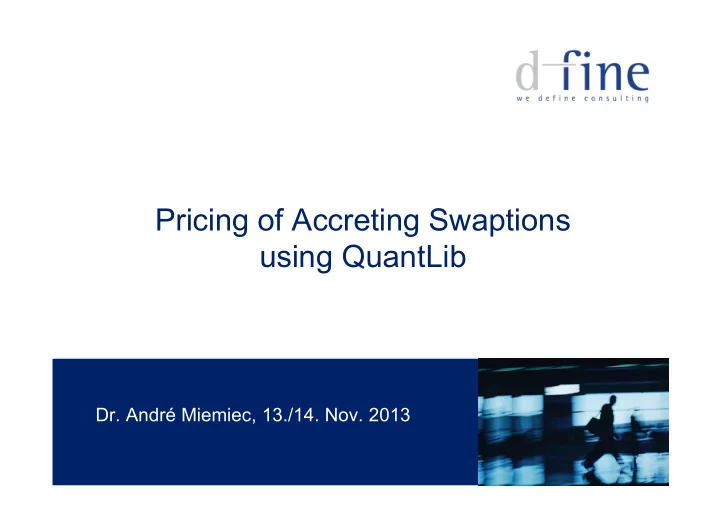

Pricing of Accreting Swaptions using QuantLib Dr. André Miemiec, 13./14. Nov. 2013
Agenda 1. Introduction 2. Model Description 3. Implementation in QuantLib 4. Pricing Quality
Introduction ● Origin of the problem: � Valuation of Multicallable Accreting Swaptions ● Elementary Observations: Picture removed
Introduction ● Reason must be traced back to the model choice or calibration, respectively Quality of Models Black 1F Short-Rate Market Model Properties: Properties: Properties: - best achievable - easy to impl. - depends on parallel price - easy to integrate shifts of yc, only - lots of choices in - applicable to - nested calibration calibrating the single callables required modell only HK-Pricer ● Amortising swaptions are most sensitive to ‘parallel’ moves in the yield curve, so a single factor model is sufficient � LGM
Introduction ● QuantLib does not provide a LGM implementation but posseses an unsatisfactory implementation of Hull-White ● Calibration Issue: � Accreters are calibrated to coinitial not coterminal swaptions � HW is unable to cope with this requirement. ● I had to decide between two alternatives: � do a proper LGM implementation or � do the calibration otherwise. ● Made the second choice because � the method selected combines the best properties of the Black and 1F-Short-Rate Models.
Agenda 1. Introduction 2. Model Description 3. Implementation in QuantLib 4. Pricing Quality
Model Description ● Irregular swap and its decomposition into a basket of regular swaps N n _ � _ N 2 _ N 1 coinitial swaps ● Hagan * : Want to exercise all basket swaps at the same time, i.e. put them equally far (λ) from ATM (K i ) R i = K i + λ * The corresponding reference can be found at the end of the talk.
Model Description ● Bond model of a accreting swaption: Fixed Leg: Float Leg: ● Basket of standard swaps with par-rates {K i } i=1..n and notionals {A i } i=1..n ● Matching the floating leg: �
Model Description ● Basket decomposition: ● Hunt-Kennedy ** : � Select r* such that: � � � � � Select R i such that: • Then ● This decomposition works pretty well, if Hagan’s R i are actually used. � Typical deviation to a properly calibrated LGM modell some $100 ** The corresponding reference can be found at the end of the talk.
Agenda 1. Introduction 2. Model Description 3. Implementation in QuantLib 4. Pricing Quality
Implementation in QuantLib ● Basic structure of the algorithm Instruments PricingEngine MarketData IrrSwap SwptnVol HaganIrregularSwaptionEngine void calculate() const; IrrSwptn YTStruct Real HKPrice (Basket&,H) const; Basket Disposable<Array> compute(Rate lambda = 0.0) const; Mutuable Real lambda_; SVD Black76 Bisection
Implementation in QuantLib ● Final Pricing Function: Real HKPrice(Basket& basket,boost::shared_ptr<Exercise>& exercise) const { boost::shared_ptr<PricingEngine> blackSwaptionEngine = boost::shared_ptr<PricingEngine>( new BlackSwaptionEngine(termStructure_,volatilityStructure_)); Disposable<Array> weights = basket.weights(); Real npv = 0.0; for(Size i=0; i<weights.size(); ++i){ boost::shared_ptr<VanillaSwap> pvSwap_ = basket.component(i); Swaption swaption = Swaption(pvSwap_,exercise); swaption.setPricingEngine(blackSwaptionEngine); npv += weights[i]*swaption.NPV(); } return npv; }
Implementation in QuantLib Side remark on standard QL-Classes: • Observation: � Implementation of Swaption-Instrument is tightly bound to the implementation of a VanillaSwap-Instrument � � � � • Suggestion: � Need for a Constructor of class VanillaSwap, who allows for all sorts of schedules ☺ ☺ ☺ ☺ Future developments regarding this piece of code: • automatic calibration of a bermudan swaption (get rid of tedious nested calibration) • Full fledged LGM model with all sorts of calibrations
Agenda 1. Introduction 2. Model Description 3. Implementation in QuantLib 4. Pricing Quality
Pricing Quality: Example Callable Zerobond IRR = 4,1055% €100Mio call date call date today 6 call dates € 20Mio ‘12 ‘15 ‘22 ‘47 ‘52 1. With original calibration from FO-System: From FO-System : Benchmarking : PV-QuantLib: € 6.. PV-FO-System: € 6.. PV01: € 100k ∆PV ≈ ≈ ≈ 0.2 bp ≈
Pricing Quality: Example Callable Zerobond 2. Comparison against market prices with own calibration from QuantLib: Picture removed
Pricing Quality ● Main Result: improved fitness of prices to market ● Reason for the observed effects: � Because the HK-Prices of Accreting Swaptions are pretty close to the corresponding LGM Prices the new calibration is more consistent than the result of a calibration based on a weighted vol (Black) approach. ~ The End ~
References ● P.S. Hagan, Methodology for Callable Swaps and Bermudan Exercise into Swaptions ● P.J. Hunt, J.E. Kennedy, Implied interest rate pricing models, Finance Stochast. 2, 275–293 (1998) ● A. Miemiec, QuantLib Code on SourceForge, (2013)
Recommend
More recommend